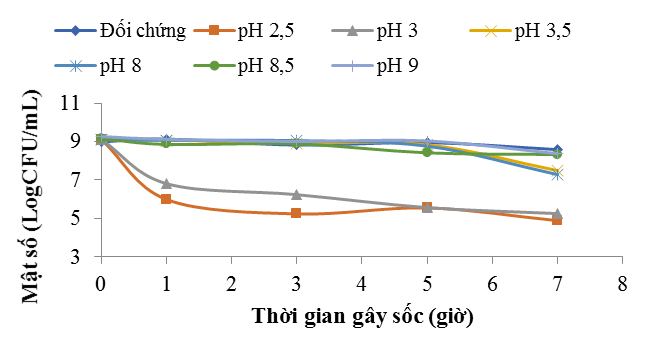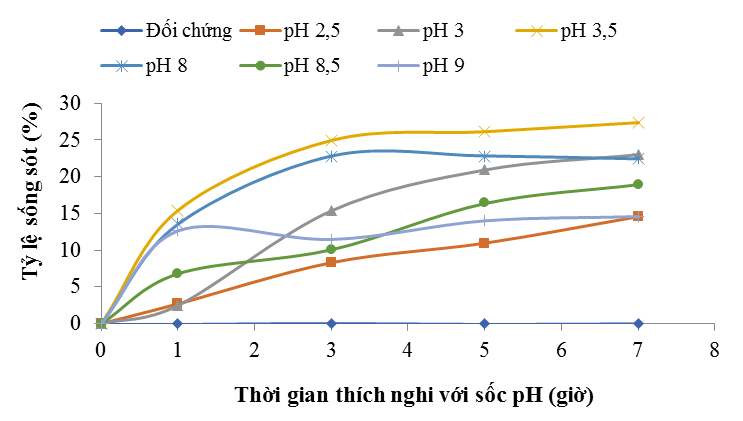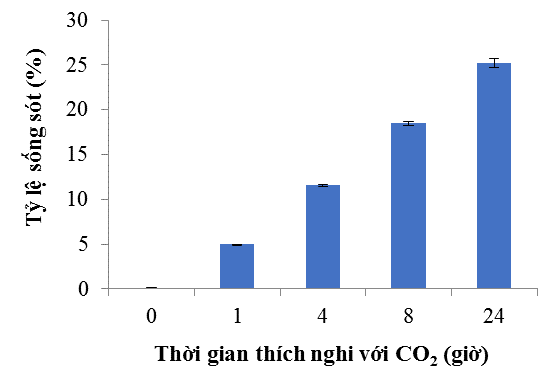Improving the Survival of Lactobacillus plantarum VAL6 Through Adaptive Responses to Environmental Stress
In recent years, probiotics have been widely applied in the food and pharmaceutical industries due to their health benefits. Many commercial probiotic formulations today are composed of lactic acid bacteria (LAB). Numerous well-known and generally recognized as safe LAB belong to the genus Lactobacillus, which are commonly used in the fermentation of vegetables, fruits, and dairy products. Lactobacillus species are also part of the normal mucosal microbiota of humans and animals. They are predominantly facultative or obligate anaerobes, non-pathogenic, and favor the acidic environment of the gastrointestinal tract. Studies show that consuming Lactobacillus probiotics helps maintain health and prevent intestinal infections. Therefore, the most commonly used Lactobacillus species in probiotic preparations include: Lactobacillus acidophilus, Lactobacillus plantarum, Lactobacillus casei, Lactobacillus paracasei, Lactobacillus johnsonii, Lactobacillus reuteri, and Lactobacillus rhamnosus.
In food and pharmaceutical applications, powdered probiotic formulations are more convenient for transport and integration into other processes such as mixing and tableting. Compared to liquid products, powdered formulations have advantages in preserving the activity of bioactive components and extending shelf life. However, the production efficiency and survival rate of LAB during drying and storage are often low, resulting in high production costs and short shelf life. One study showed that the survival rate of L. plantarum after spray drying was only about 0.85%. Low survival rates and short shelf life significantly increase the cost, limiting the application of probiotic formulations.
The survival of probiotic bacteria during production and application depends on many factors, such as strain selection, culture conditions, fermentation environment, drying conditions, and the selection of food matrices to ensure the bacteria reach the intestine alive. The physiological state of cells adapted to the culture environment may also be a major factor affecting the viability of probiotic bacteria. For instance, adaptation to environmental stresses can improve bacterial resistance to freezing and drying. To induce cellular adaptive responses, researchers have attempted to culture Lactobacillus under sub-lethal conditions, including elevated or reduced temperatures, changes in pH, oxygen levels, and osmotic pressure, as well as the addition of inhibitory substances such as bile salts.
In this study, to demonstrate that adaptation of LAB to environmental stress can improve cell survival during freeze-drying, L. plantarum VAL6 was cultured under various stress conditions including temperature, pH, and elevated CO₂ levels. Improved survival was evaluated through changes in bacterial counts during the stress period and survival rates after freeze-drying.
Materials and Methods
Materials
The L. plantarum VAL6 strain was provided by the Department of Biotechnology, Faculty of Agriculture and Natural Resources, An Giang University, Vietnam National University, Ho Chi Minh City. The Man Rogosa Sharpe (MRS) culture medium included: Yeast extract 2%; Peptone 1%; Glucose 2%; NaCl 0.5%; K₂HPO₄ 0.2%; MgSO₄ 0.02%; MnSO₄ 0.004%; Tween 80 0.1%.
Methods
Environmental stress experiments were conducted independently in a 5-liter bioreactor (BIOSTAT, Sartorius Stedim, Germany). Specifically, 5 L of MRS medium was inoculated with 100 mL of bacterial suspension (OD₅₉₅=1.5) and cultured under normal conditions (pH 6.8, 37°C, stirring at 250 rpm) for 24 hours.
To evaluate the effect of pH shock, after 24 hours of normal culturing, cultures were exposed to pH values of 2.5, 3, 3.5, 8, 8.5, and 9. Exposure durations were 1, 3, 5, and 7 hours.
To assess the effect of heat shock, cultures were exposed to temperatures of 15, 25, 42, and 47°C for the same durations.
CO₂ enrichment was applied from the beginning of culture by continuously supplying CO₂ at 50 cm³/L/min.
Results and Discussion
Changes in Bacterial Counts Under Environmental Stress
L. plantarum VAL6 counts remained relatively stable under pH 3.5 and alkaline pH stress. However, under low pH (2.5–3), bacterial counts dropped significantly. At pH 2.5 and 3, counts dropped quickly to 6 and 6.8 Log CFU/mL after 1 hour and then decreased slightly over time. In contrast, under high pH (8–9) or pH 3.5, counts remained mostly unchanged throughout stress duration.

Under thermal stress (Figure 3), counts were relatively stable. At 42°C, counts averaged around 9.2 Log CFU/mL, not significantly different (p > 0.05) from the control. At 47°C, counts slightly declined to 8.38 Log CFU/mL after 7 hours. At lower temperatures (15 and 25°C), counts declined slightly after 1 hour, ranging from 8.5 to 8.7 Log CFU/mL.

Unlike other stressors, CO₂ enrichment stimulated an increase in L. plantarum VAL6 counts (Figure 4). With CO₂ supplementation, counts ranged from 9.2–9.4 Log CFU/mL compared to ~9 Log CFU/mL without CO₂. There was no significant difference (p > 0.05) between 4 and 24 hours of CO₂ treatment.

Studies have shown Lactobacillus probiotics can transit the stomach and colonize the intestines of humans and animals, enhancing host health. For effectiveness, probiotics must survive the gastrointestinal tract and reach the small intestine. These bacteria must endure harsh gastrointestinal conditions [18]. Hence, determining the stress tolerance of probiotic strains is essential. This study demonstrated that L. plantarum VAL6 can survive extreme conditions such as very low pH (2.5), high temperature (47°C), and anaerobic environments created by CO₂—indicating its probiotic potential.
Freeze-Drying Survival of L. plantarum VAL6
To verify whether adaptation to environmental stress improves freeze-drying survival, survival rates of stressed and non-stressed bacteria were compared.
Results showed that pH shock significantly improved L. plantarum VAL6 survival during freeze-drying (Figure 5). Survival increased with longer adaptation, reaching nearly 28% after 7 hours at pH 3.5, compared to only ~0.01% in the non-stressed control.

Similarly, heat shock adaptation increased survival significantly (Figure 6). Longer adaptation durations correlated with higher survival. The best survival (~8–10%) was observed with 3–7 hours of heat shock at 47°C.

Accompanying the increased bacterial counts, CO₂-treated L. plantarum VAL6 showed improved survival with longer CO₂ exposure (Figure 7). After 1 hour of CO₂, survival was 4.97%; after 24 hours, survival exceeded 25%.

Microbial survival and development depend on their ability to sense and respond to environmental factors such as temperature, pH, nutrient availability, and population density. Environmental stress may induce bacteria to synthesize factors that help resist adverse conditions.
Conclusion
This study demonstrated that using environmental stress to stimulate cellular adaptive responses before freeze-drying can improve bacterial survival. This highlights the potential of environmental stress adaptation to enhance LAB starter strain survival in food applications.
The probiotic potential of L. plantarum VAL6 was confirmed through its ability to survive extreme conditions such as very low pH (2.5), high temperature (47°C), and CO₂-induced anaerobic conditions. Notably, CO₂-enriched cultivation stimulated an increase in bacterial counts. Adaptation to stressors such as temperature, pH, and CO₂ enrichment significantly improved L. plantarum VAL6 survival. The highest survival rate (28%) was observed in cells adapted to pH 3.5 for 5 hours—approximately 2,500 times higher than the control.
Ngày đăng: 29-05-2025

